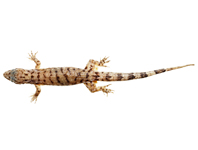Abstract
Little is known about the worm-eating snakes of the genus Trachischium in the East Himalaya due to their secretive nature. To date, only T. monticola and T. tenuiceps are recorded from China, and the former species was recorded based on historical literature without vouchered information. In addition, a questionable record of T. guentheri in Tibet, China exists in literature, but no one has yet confirmed this distribution record. Here we confirm the distribution of T. guentheri in southeastern Tibet, China based on a newly collected specimen, and provide the first detailed description of T. monticola, including the first description of its hemipenial morphology, based on newly collected Tibetan specimens. Lastly, we provide a diagnostic key to the three Chinese species, and discuss the general distribution patterns of the genus in the Trans-Himalayan Region.
References
Annandale, N. (1912) Zoological results of the Abor Expedition, 1911-1912. II. Reptilia. Records of the Indian Museum, 8, 37–59.
https://doi.org/10.5962/bhl.part.1186
Boulenger, G.A. (1890) The Fauna of British India, including Ceylon and Burma, Reptilia and Batrachia. Taylor and Francis, London, 541 pp.
https://doi.org/10.5962/bhl.title.57017
Boulenger, G.A. (1893) Catalogue of the snakes in the British Museum (Natural History). Vol. I. Taylor and Francis, London, 448 pp.
Blyth, E. (1855 [1854]) Notices and descriptions of various reptiles, new or little known (part II). The Journal of Asiatic Society of Bengal, 23 (3), 287–302.
Cai, B., Wang, Y., Chen, Y. & Li, J. (2015) A revised taxonomy for Chinese reptiles. Biodiversity Science, 23 (3), 365–382. [in Chinese] http://doi.org/10.17520/biods.2015037
Cantor, T.E. (1839) Spicilegium serpentium indicorum (part 1). Proceedings of the Zoological Society of London, 1839, 31–34.
Chettri, B., Bhupathy, S. & Acharya, B.K. (2009) Morphometry and aspects of breeding biology of Trachischium guentheri Boulenger, 1890 (Serpentes: Colubridae) in north Sikkim, eastern Himalaya, India. Russian Journal of Herpetology, 16 (3), 177–182.
http://doi.org/1026-2296/2009/1603-0177
Dowling, H.G. (1951) A proposed standard system of counting ventral in snakes. British Journal of Herpetology, 1 (5), 97–99.
Dowling, H.G. & Savage, J.M. (1960) A guide to the snake hemipenis: a survey of basic structure and systematic characteristics. Zoologica, 45 (2), 17–29.
Guo, P., Liu, Q., Xu, Y., Jiang, K., Hou, M., Ding, L., Pyron, R.A. & Burbrink, F.T. (2012) Out of Asia: natricine snakes support the Cenozoic Beringian Dispersal Hypothesis. Molecular Phylogenetics and Evolution, 63, 825–833.
http://doi.org/10.1016/j.ympev.2012.02.021
Günther, A. (1858) Catalogue of Colubrine snakes in the collection of the British Museum. Order of the trustees, London, xvi+ 281 pp.
Hu, S. (1987) Amphibia-Reptilia of Xizang. Science Press, Beijing, 153 pp. [in Chinese]
Li, P., Zhao, E. & Dong, B. (2010) Amphibians and Reptiles of Tibet. Science Press, Beijing, 251 pp. [in Chinese]
Perecca, M.G. (1904) Nouvelles espèces d’Ophidiens d’Asie et d’Amerique, fausant partie de la collection du Museum d’historie naturelle de Genève. Revue Suisse de Zoologie, 12, 663–668.
https://doi.org/10.5962/bhl.part.10151
Raha, S., Sunandan, D., Probhat, B., Sudipta, D. & Kousik, P. (2018) Description of a new species of the genus Trachischium with a redescription of Trachischium fuscum (Serpentes: Colubridae: Natricinae). Zootaxa, 4370 (5), 549–561.
https://doi.org/10.11646/zootaxa.4370.5.6
Schleich, H.H. & Kästle, W. (2002) Amphibians and Reptiles of Nepal. Koeltz Scientific Books, Ruggell, 1211 pp.
Smith, M.A. (1943) The Fauna of British India, Reptilia and Amphibia. Vol.III. Serpentes. Taylor and Francis, London, 583 pp.
Swofford, D.L. (2002) PAUP*: phylogenetic analysis using parsimony. Version 4.0 b10. Sinauer Associates, Sunderland. [program]
Wallach, V. (1988) Status and re-description of the genus Padangia Werner, with comparative visceral data on Collorhabdium Smedley and other genera (Serpentes: Colubridae). Amphibia-Reptilia, 9 (1), 61–76.
https://doi.org/10.1163/156853888X00215
Zhang, F., Hu, S. & Zhao, E. (1984) Comparative studies and phylogenetic discussions on hemipenial morphology of the Chinese (Colubrinae). Acta Herpetologica Sinica, 3 (3), 23–44. [in Chinese]
Zhao, E. (2006) Snakes of China. Anhui Science and Technology Publishing House, Hefei, 669 pp. [in Chinese]
Zhao, E., Huang, M. & Zong, Y. (1998) Fauna Sinica: Reptilia, Vol.3. Squamata, Serpentes. Science Press, Beijing, 522 pp. [in Chinese]

